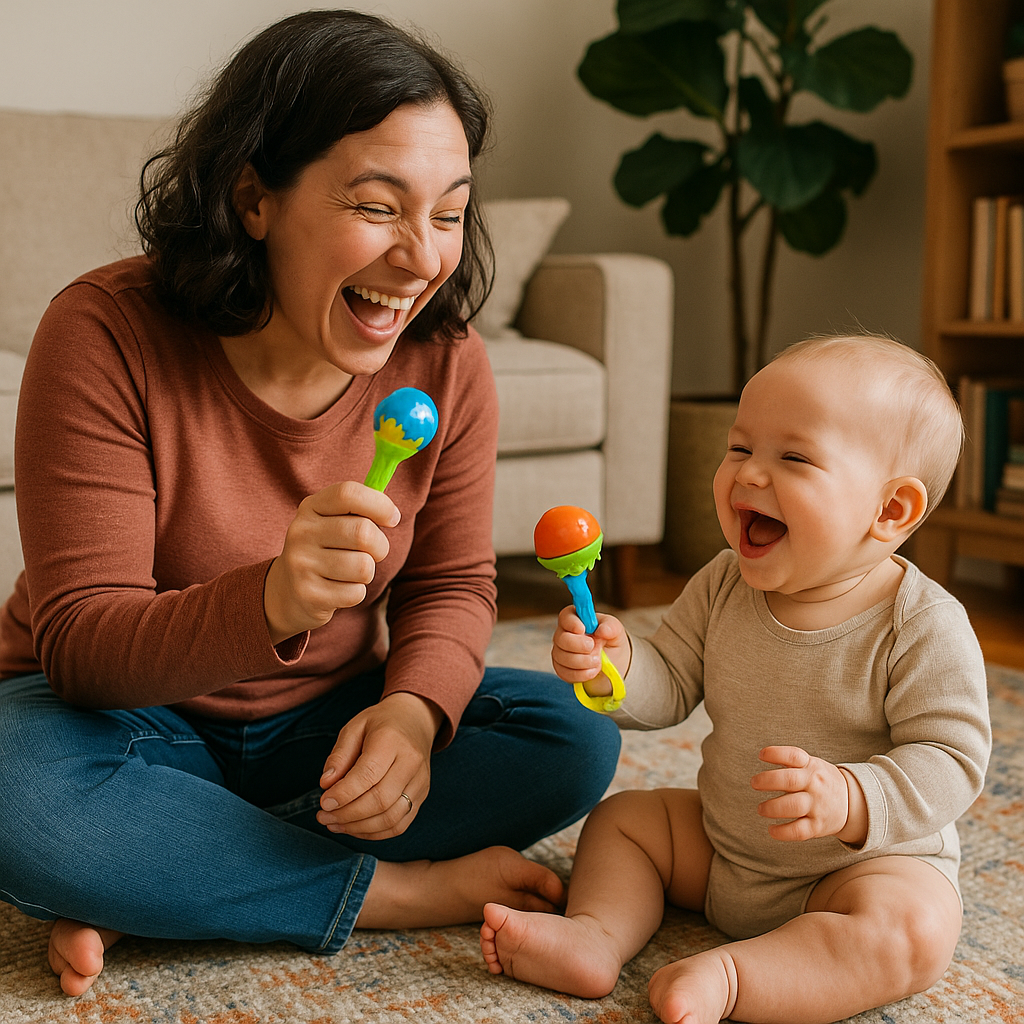Imagine your 10-month-old scooting across the floor to offer a teddy bear to a crying playmate—a small but powerful act of empathy. Neuroscience suggests that babies as young as newborns begin to mirror and absorb emotions, with the first year being a critical window for developing the brain circuits that drive compassion and emotional intelligence. Let’s see day-to-day strategies so you can nurture empathy and emotional intelligence from birth.
- What does empathy look like in a baby, and when does it emerge?
- How do secure attachment and serve-and-return interactions wire a baby’s brain for empathy?
- Which everyday routines quietly build emotional intelligence in the first year?
- How can you model and manage your own emotions to teach empathy?
- What if my baby is highly sensitive, or our family context is different?
- Your top questions about raising an empathetic baby, answered
- Why early empathy shapes your baby’s future relationships
What does empathy look like in a baby, and when does it emerge?
Empathy begins with emotional contagion in the first weeks of life and evolves into more complex forms by the end of the first year. Newborns exhibit “contagious crying,” where they cry in response to another infant’s distress, reflecting an innate sensitivity to emotions. By 6 months, EEG studies show mirror-neuron activation when babies observe facial expressions, indicating they are processing others’ emotions. Learn about neural mechanisms. Around 8-10 months, babies may pause, frown, or reach out when they see someone upset, showing early signs of concern.
Empathy develops in stages:
- Birth–6 months: Emotional contagion and social smiling, where babies mimic caregivers’ expressions.
- 7–12 months: Concern gestures, such as stroking hair or offering a toy to comfort someone.
- 18–36 months: Cognitive empathy emerges, with toddlers recognizing that others’ feelings differ from their own.
Empathy differs from sympathy (feeling for someone) and compassion (wanting to help), but all rely on early neural wiring. See How Babies Learn Emotions.
For more on how babies decode feelings, visit How Babies Learn Emotions from Parents.

How do secure attachment and serve-and-return interactions wire a baby’s brain for empathy?
A secure bond with caregivers fosters trust and emotional regulation, essential for empathy. Responsive caregiving releases oxytocin, which enhances social bonding and supports neural development in the prefrontal cortex and amygdala, areas linked to emotional processing. Securely attached infants are more sensitive to others’ emotional needs, as they feel safe exploring social interactions. See Secure Attachment.
Serve-and-return interactions—where caregivers respond to a baby’s cues with smiles, coos, or gestures—strengthen these neural pathways. For example, when a parent mimics a baby’s babble or soothes a cry, it builds emotional attunement. Research shows infants with rich serve-and-return experiences score 30% higher on emotion-reading tasks by age 2. Explore Serve-and-Return.
Practical ways to engage include:
- Face-to-Face Play: Exaggerated peek-a-boo or mirroring facial expressions.
- Imitation Games: Copying a baby’s sounds and pausing for their response.
- Rattle Duets: Taking turns shaking a rattle to encourage reciprocity.
Deepen your toolkit with Secure Attachment and Serve-and-Return.

Which everyday routines quietly build emotional intelligence in the first year?
Simple daily activities can quietly nurture emotional intelligence, laying the groundwork for empathy. These routines leverage repetition and relationships to teach babies about emotions:
| Routine | How It Builds Emotional Intelligence | Example |
|---|---|---|
| Diaper Changes | Labeling emotions (e.g., “You look relieved!”) helps babies connect feelings to experiences. | “You seem happy now that your diaper is clean!” |
| Feeding Time | Eye contact and gentle touch synchronize heart rates, fostering emotional connection. | Maintain eye contact while feeding to build trust. |
| Bedtime Stories | Books with expressive faces teach emotion recognition; asking “How does bunny feel?” engages curiosity. | Read books like The Feelings Book by Todd Parr. |
| Family Photos | Displaying photos at baby’s eye level with varied emotions sharpens recognition skills. | Rotate photos showing happy, sad, or surprised faces. |
| Low-Stress Environment | Soft lighting and low noise reduce cortisol, supporting emotional regulation. | Use dim lights and quiet music during playtime. Check Low-Stress Environment. |
| Infant Massage | Gentle strokes after baths stimulate the vagus nerve, promoting soothing and emotional calm. | Massage baby’s arms and legs post-bath. See Infant Massage. |
These routines create a predictable, supportive environment that enhances emotional awareness and empathy. Explore routine benefits and Low-Stress Environment lowers cortisol that blunts empathy.
How can you model and manage your own emotions to teach empathy?
Parents can teach empathy by modeling healthy emotional regulation. Babies observe their caregivers’ tone, heart rate, and behavior, learning how to manage emotions. A practical strategy is the Pause-Name-Explain script: “I’m pausing… I feel frustrated… I’ll take a deep breath.” This shows babies that emotions can be managed calmly.
Additional tips include:
- Mindfulness Breaks: Take five slow breaths during naps to reset your nervous system, helping you stay calm.
- Empathetic Boundaries: Set limits with care, e.g., “I hear you’re upset, but banging hurts. Let’s tap gently.”
- Kind Interactions: Show respect and kindness in daily interactions, as babies learn empathy by observing.
If work stress looms, weigh the pros and cons in Daycare vs. Stay-Home.
What if my baby is highly sensitive, or our family context is different?
Highly sensitive infants (HSIs), who may startle at loud noises or cling in crowds, need tailored support to develop empathy without becoming overwhelmed. Strategies include:
- Peace Corner: Create a calm space with dim lights, soft fabrics, and sensory toys to help HSIs decompress. Check Support sensitive children.
- Acknowledge and Stay Calm: During meltdowns, acknowledge distress once (e.g., “I see you’re upset”), then remain a quiet, calm presence to model regulation.
- Gradual Exposure: Introduce small challenges, like meeting new people, to build resilience without overwhelming the baby.
Diverse family contexts require inclusive approaches. For example:
- Cultural Practices: In cultures like Kenya or Japan, baby-wearing enhances soothing and empathy, as studies show higher soothing responses at 12 months.
- Inclusive Caregiving: Encourage all caregivers—fathers, grandparents, or non-binary relatives—to engage in empathy-building activities.
- Pet Interactions: Supervised interactions with calm pets can teach emotional co-regulation. See Family and Pets and Family and Pets.
- Screen Management: Limit foreground screens during play, as a 2019 study linked heavy parental phone use to poorer infant emotion reading.
These adaptations ensure empathy development is accessible across temperaments and family structures. Explore sensitive childcare.
Your top questions about raising an empathetic baby, answered
-
Can empathy be taught before my baby talks?
Yes, empathy can be nurtured preverbally. Mirroring facial expressions, naming emotions during routines, and responding to cries with soothing motions wire the brain for empathy. Learn early empathy strategies. -
Could too much empathy overwhelm my child later?
Balanced empathy prevents overwhelm. Teach self-soothing (e.g., deep breathing) and praise caring actions without encouraging constant people-pleasing. This helps children stay empathetic while managing their emotions. For social stress tips, review Stranger Anxiety. -
What books or toys build empathy under age 1? High-contrast emotion cards, plush dolls with diverse skin tones, and infant-safe mirrors promote self-other awareness and inclusive caring. These tools help babies recognize emotions and develop empathy early.
Why early empathy shapes your baby’s future relationships
The small moments you share with your baby—responding to cries, naming emotions, or staying calm during stress—build the neural foundation for empathy. These early interactions shape future relationships, fostering kindness and resilience. Try an emotion-naming routine tonight, like during a diaper change, and explore Face-to-Face Play for more ways to connect. By nurturing empathy now, you’re giving your child the roots for compassionate, meaningful connections throughout life.